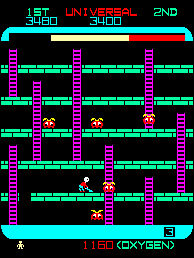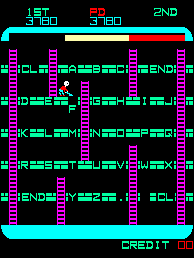 The Game: An astronaut is trapped in an enclosed, vertical space with aliens who have a taste for human flesh. With his oxygen supply running out, he must dig holes in the floors of the multi-level structure and lure the aliens into those holes, which gives him mere seconds to dispose of the trapped aliens by filling the holes in. Clearing a level of aliens replenishes the oxygen tank and deposits the player on a new screen full of aliens, some of whom require extra effort – namely, the carefully-planned digging of an entire vertical shaft to fall through – to kill. (Universal, 1980)
The Game: An astronaut is trapped in an enclosed, vertical space with aliens who have a taste for human flesh. With his oxygen supply running out, he must dig holes in the floors of the multi-level structure and lure the aliens into those holes, which gives him mere seconds to dispose of the trapped aliens by filling the holes in. Clearing a level of aliens replenishes the oxygen tank and deposits the player on a new screen full of aliens, some of whom require extra effort – namely, the carefully-planned digging of an entire vertical shaft to fall through – to kill. (Universal, 1980)
Memories: A fiendishly hard and oft-copied game (particularly in the home computer arena, where it inspired such games as Apple Panic and Lode Runner), Space Panic may well be the first game of its kind: a game in which the player controls someone climbing up and down vertical levels on the screen.
 And even such things as the high score initial screen seems to indicate that Universal – a frequently unsung arcade innovator – knew it was onto something cool. The first climbing game most gamers remember playing – Donkey Kong – was a year away. Nichibutsu‘s Crazy Climber was also out in 1980, and involved a vertical climb, but Space Panic was the first game with levels and ladders.
And even such things as the high score initial screen seems to indicate that Universal – a frequently unsung arcade innovator – knew it was onto something cool. The first climbing game most gamers remember playing – Donkey Kong – was a year away. Nichibutsu‘s Crazy Climber was also out in 1980, and involved a vertical climb, but Space Panic was the first game with levels and ladders.
Space Panic wasn’t just a walk in the park, though, and there’s a reason that its basic play mechanics were co-opted by other games that have become much better known. The player’s character had  to be positioned just right to be able to start digging or filling in a hole; if the positioning wasn’t perfect, the player couldn’t dig and, in all likelihood, would wind up with a dead on-screen character in very short order. Space Panic could be fantastically frustrating.
to be positioned just right to be able to start digging or filling in a hole; if the positioning wasn’t perfect, the player couldn’t dig and, in all likelihood, would wind up with a dead on-screen character in very short order. Space Panic could be fantastically frustrating.
 Despite that, the game is still worthy of its status as an arcade game that broke new ground. It’s entirely probable that someone would still have created a ladders-and-levels game if Space Panic hadn’t come along, but this is the game that got there first.
Despite that, the game is still worthy of its status as an arcade game that broke new ground. It’s entirely probable that someone would still have created a ladders-and-levels game if Space Panic hadn’t come along, but this is the game that got there first.
